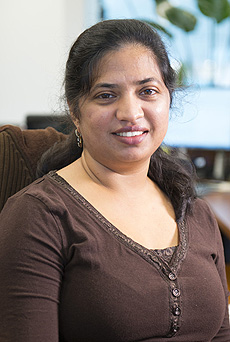One minute with Hema Ramamoorthi, Directorate chief of staff
 |
As chief of staff for the Directorate, Hema Ramamoorthi is key to the LBNF/DUNE program. Photo: Reidar Hahn |
How did you end up at Fermilab?
I have an engineering background — a Bachelor of Engineering in electronics and instrumentation from India. I have a keen interest in government relations. I worked 10 years as an assistant to the consul general of India at the consulate in Chicago. I decided I wanted to move closer to home [in the western suburbs] because my daughter was 18 months old, and I wanted to spend more time with her. Then I saw the opening at Fermilab ...
How long have you been at Fermilab?
Five years. I started here as the administrative assistant in the Program Planning Office for about three-and-a-half years. In early 2014, I started working as the executive assistant to the lab director, and from Oct. 1, the chief of staff to the Directorate.
What does your typical day look like, and what is your role at the laboratory?
It usually starts early. After dropping my daughter off at school, my workday is challenging, busy and exciting. I like that and the fast pace.
In my present role I provide comprehensive administrative policy and programmatic support, strategic planning and international engagement for the Director's Office, including the laboratory director, deputy director and chief operating officer. As part of my role I serve as an integrator and facilitate the lab director's agenda, strategy and direction with the senior leadership team.
I find this very interesting, and my days are intense and productive.
What's the most exciting part of your job?
I work on multiple projects and interact with many people within the lab. I also work with leadership in the DOE Office of High Energy Physics, key staff members in the Office of Science, the Office of Science Technology and Policy, and the FRA Board, as well as national and international labs and especially international funding agencies. I enjoy facilitating a complex web of interactions that is rapidly emerging as the LBNF/DUNE project advances.
What are some things you like to do outside of work?
My daughter is now six years old, and I love spending time with her. My family likes to travel around the U.S. and to different countries to visit famous landmarks. I like to paint. Oil painting, mostly scenery and flowers. That helps me relax.
—Chris Patrick
|